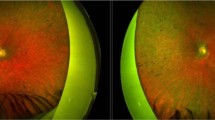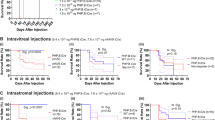Abstract
The purpose of this study was to evaluate whether immune responses interfered with gene therapy rescue using subretinally delivered recombinant adeno-associated viral vector serotype 2 carrying the RPE65 cDNA gene driven by the human RPE65 promoter (rAAV2.hRPE65p.hRPE65) in the second eye of RPE65−/− dogs that had previously been treated in a similar manner in the other eye. Bilateral subretinal injection was performed in nine dogs with the second eye treated 85–180 days after the first. Electroretinography (ERG) and vision testing showed rescue in 16 of 18 treated eyes, with no significant difference between first and second treated eyes. A serum neutralizing antibody (NAb) response to rAAV2 was detected in all treated animals, but this did not prevent or reduce the effectiveness of rescue in the second treated eye. We conclude that successful rescue using subretinal rAAV2.hRPE65p.hRPE65 gene therapy in the second eye is not precluded by prior gene therapy in the contralateral eye of the RPE65−/− dog. This finding has important implications for the treatment of human LCA type II patients.
This is a preview of subscription content, access via your institution
Access options
Subscribe to this journal
Receive 12 print issues and online access
$259.00 per year
only $21.58 per issue
Buy this article
- Purchase on Springer Link
- Instant access to full article PDF
Prices may be subject to local taxes which are calculated during checkout





Similar content being viewed by others
References
Stone EM . Leber congenital amaurosis—a model for efficient genetic testing of heterogeneous disorders: LXIV Edward Jackson Memorial Lecture. Am J Ophthalmol 2007; 144: 791–811.
Gu SM, Thompson DA, Srikumari CR, Lorenz B, Finckh U, Nicoletti A et al. Mutations in RPE65 cause autosomal recessive childhood-onset severe retinal dystrophy. Nat Genet 1997; 17: 194–197.
Marlhens F, Bareil C, Griffoin JM, Zrenner E, Amalric P, Eliaou C et al. Mutations in RPE65 cause Leber's congenital amaurosis. Nat Genet 1997; 17: 139–141.
Veske A, Nilsson SE, Narfstrom K, Gal A . Retinal dystrophy of Swedish briard/briard-beagle dogs is due to a 4-bp deletion in RPE65. Genomics 1999; 57: 57–61.
Aguirre GD, Baldwin V, Pearce-Kelling S, Narfstrom K, Ray K, Acland GM . Congenital stationary night blindness in the dog: common mutation in the RPE65 gene indicates founder effect. Mol Vis 1998; 4: 23.
Acland GM, Aguirre GD, Ray J, Zhang Q, Aleman TS, Cideciyan AV et al. Gene therapy restores vision in a canine model of childhood blindness. Nat Genet 2001; 28: 92–95.
Narfstrom K, Katz ML, Ford M, Redmond TM, Rakoczy E, Bragadottir R . In vivo gene therapy in young and adult RPE65−/− dogs produces long-term visual improvement. J Hered 2003; 94: 31–37.
Acland GM, Aguirre GD, Bennett J, Aleman TS, Cideciyan AV, Bennicelli J et al. Long-term restoration of rod and cone vision by single dose rAAV-mediated gene transfer to the retina in a canine model of childhood blindness. Mol Ther 2005; 12: 1072–1082.
Narfstrom K, Bragadottir R, Redmond TM, Rakoczy PE, van VT, Bruun A . Functional and structural evaluation after AAV.RPE 65 gene transfer in the canine model of Leber's congenital amaurosis. Adv Exp Med Biol 2003; 533: 423–430.
Le Meur G, Stieger K, Smith AJ, Weber M, Deschamps JY, Nivard D et al. Restoration of vision in RPE65-deficient Briard dogs using an AAV serotype 4 vector that specifically targets the retinal pigmented epithelium. Gene Ther 2007; 14: 292–303.
Bennicelli J, Wright JF, Komaromy A, Jacobs JB, Hauck B, Zelenaia O et al. Reversal of blindness in animal models of Leber congenital amaurosis using optimized AAV2-mediated gene transfer. Mol Ther 2008; 16: 458–465.
Narfstrom K, Vaegan, Katz M, Bragadottir R, Rakoczy EP, Seeliger M . Assessment of structure and function over a 3-year period after gene transfer in RPE65−/− dogs. Doc Ophthalmol 2005; 111: 39–48.
Narfstrom K, Katz ML, Bragadottir R, Seeliger M, Boulanger A, Redmond TM et al. Functional and structural recovery of the retina after gene therapy in the RPE65 null mutation dog. Invest Ophthalmol Vis Sci 2003; 44: 1663–1672.
Bainbridge JW, Smith AJ, Barker SS, Robbie S, Henderson R, Balaggan K et al. Effect of gene therapy on visual function in Leber's congenital amaurosis. N Engl J Med 2008; 358: 2231–2239.
Maguire AM, Simonelli F, Pierce EA, Pugh Jr EN, Mingozzi F, Bennicelli J et al. Safety and efficacy of gene transfer for Leber's congenital amaurosis. N Engl J Med 2008; 358: 2240–2248.
Hauswirth W, Aleman TS, Kaushal S, Cideciyan AV, Schwartz SB, Wang L et al. Phase I Trial of Leber congenital amaurosis due to RPE65 mutations by ocular subretinal injection of adeno-associated virus gene vector: short-term results. Hum Gene Ther 2008; 19: 979–990.
Zaiss AK, Muruve DA . Immune responses to adeno-associated virus vectors. Curr Gene Ther 2005; 5: 323–331.
Halbert CL, Standaert TA, Aitken ML, Alexander IE, Russell DW, Miller AD . Transduction by adeno-associated virus vectors in the rabbit airway: efficiency, persistence, and readministration. J Virol 1997; 71: 5932–5941.
Halbert CL, Rutledge EA, Allen JM, Russell DW, Miller AD . Repeat transduction in the mouse lung by using adeno-associated virus vectors with different serotypes. J Virol 2000; 74: 1524–1532.
Halbert CL, Standaert TA, Wilson CB, Miller AD . Successful readministration of adeno-associated virus vectors to the mouse lung requires transient immunosuppression during the initial exposure. J Virol 1998; 72: 9795–9805.
Wang Z, Allen JM, Riddell SR, Gregorevic P, Storb R, Tapscott SJ et al. Immunity to adeno-associated virus-mediated gene transfer in a random-bred canine model of Duchenne muscular dystrophy. Hum Gene Ther 2007; 18: 18–26.
Moss RB, Rodman D, Spencer LT, Aitken ML, Zeitlin PL, Waltz D et al. Repeated adeno-associated virus serotype 2 aerosol-mediated cystic fibrosis transmembrane regulator gene transfer to the lungs of patients with cystic fibrosis: a multicenter, double-blind, placebo-controlled trial. Chest 2004; 125: 509–521.
Limberis MP, Wilson JM . Adeno-associated virus serotype 9 vectors transduce murine alveolar and nasal epithelia and can be readministered. Proc Natl Acad Sci USA 2006; 103: 12993–12998.
Anand V, Duffy B, Yang Z, Dejneka NS, Maguire AM, Bennett J . A deviant immune response to viral proteins and transgene product is generated on subretinal administration of adenovirus and adeno-associated virus. Mol Ther 2002; 5: 125–132.
Li Q, Miller R, Han PY, Pang J, Dinculescu A, Chiodo V et al. Intraocular route of AAV2 vector administration defines humoral immune response and therapeutic potential. Mol Vis 2008; 14: 1760–1769.
Anand V, Chirmule N, Fersh M, Maguire AM, Bennett J . Additional transduction events after subretinal readministration of recombinant adeno-associated virus. Hum Gene Ther 2000; 11: 449–457.
Barker SE, Broderick CA, Robbie SJ, Duran Y, Natkunarajah M, Buch P et al. Subretinal delivery of adeno-associated virus serotype 2 results in minimal immune responses that allow repeat vector administration in immunocompetent mice. J Gene Med 2009; 11: 486–497.
Li W, Kong F, Li X, Dai X, Liu X, Zheng Q et al. Gene therapy following subretinal AAV5 vector delivery is not affected by a previous intravitreal AAV5 vector administration in the partner eye. Mol Vis 2009; 15: 267–275.
Mingozzi F, High KA . Immune responses to AAV in clinical trials. Curr Gene Ther 2007; 7: 316–324.
McPhee SW, Janson CG, Li C, Samulski RJ, Camp AS, Francis J et al. Immune responses to AAV in a phase I study for Canavan disease. J Gene Med 2006; 8: 577–588.
Gearhart PM, Gearhart CC, Petersen-Jones SM . A novel method for objective vision testing in canine models of inherited retinal disease. Invest Ophthalmol Vis Sci 2008; 49: 3568–3576.
Gilmour MA, Lehenbauer TW . Comparison of tepoxalin, carprofen, and meloxicam for reducing intraocular inflammation in dogs. Am J Vet Res 2009; 70: 902–907.
Jacobson SG, Acland GM, Aguirre GD, Aleman TS, Schwartz SB, Cideciyan AV et al. Safety of recombinant adeno-associated virus type 2-RPE65 vector delivered by ocular subretinal injection. Mol Ther 2006; 13: 1074–1084.
Mowat FM, Petersen-Jones SM, Williamson H, Williams DL, Luthert PJ, Ali RR et al. Topographical characterization of cone photoreceptors and the area centralis of the canine retina. Mol Vis 2008; 14: 2518–2527.
Gao GP, Qu G, Faust LZ, Engdahl RK, Xiao W, Hughes JV et al. High-titer adeno-associated viral vectors from a Rep/Cap cell line and hybrid shuttle virus. Hum Gene Ther 1998; 9: 2353–2362.
Petersen-Jones SM, Bartoe JT, Fischer AJ, Scott M, Boye SL, Chiodo V et al. AAV retinal transduction in a large animal model species: comparison of a self-complementary AAV2/5 with a single-stranded AAV2/5 vector. Mol Vis 2009; 15: 1835–1842.
Tuntivanich N, Pittler SJ, Fischer AJ, Omar G, Kiupel M, Weber AJ et al. Characterization of a canine model of autosomal recessive retinitis pigmentosa due to a PDE6A mutation. Invest Ophthalmol Vis Sci 2009; 50: 801–813.
Acknowledgements
This work was supported by the British Retinitis Pigmentosa Society, The Midwest Eye Banks and Transplantation Center Research Program and Michigan State University College of Veterinary Medicine Purebred Dog Endowment Fund. JWB is a Wellcome Trust Advanced Fellow. RRA and JWB are investigators at The NIHR Centre for Ophthalmology at UCl and Moorfields Eye Hospital. We acknowledge Janice Querubin for providing veterinary technician expertise in all aspects of handling and caring for the dogs and Cheri Johnson for assistance with canine reproduction.
Author information
Authors and Affiliations
Corresponding authors
Ethics declarations
Competing interests
The authors declare no conflict of interest.
Rights and permissions
About this article
Cite this article
Annear, M., Bartoe, J., Barker, S. et al. Gene therapy in the second eye of RPE65-deficient dogs improves retinal function. Gene Ther 18, 53–61 (2011). https://doi.org/10.1038/gt.2010.111
Received:
Revised:
Accepted:
Published:
Issue Date:
DOI: https://doi.org/10.1038/gt.2010.111
Keywords
This article is cited by
-
Characterization of scotopic and mesopic rod signaling pathways in dogs using the On–Off electroretinogram
BMC Veterinary Research (2022)
-
Residual rod function in CNGB1 mutant dogs
Documenta Ophthalmologica (2022)
-
ERG assessment of altered retinal function in canine models of retinitis pigmentosa and monitoring of response to translatable gene augmentation therapy
Documenta Ophthalmologica (2021)
-
Investigation of SLA4A3 as a candidate gene for human retinal disease
Journal of Negative Results in BioMedicine (2016)
-
Development of an optimized AAV2/5 gene therapy vector for Leber congenital amaurosis owing to defects in RPE65
Gene Therapy (2016)



